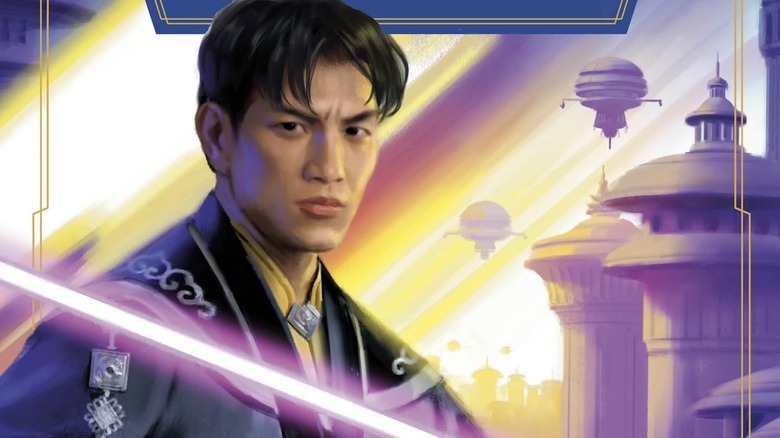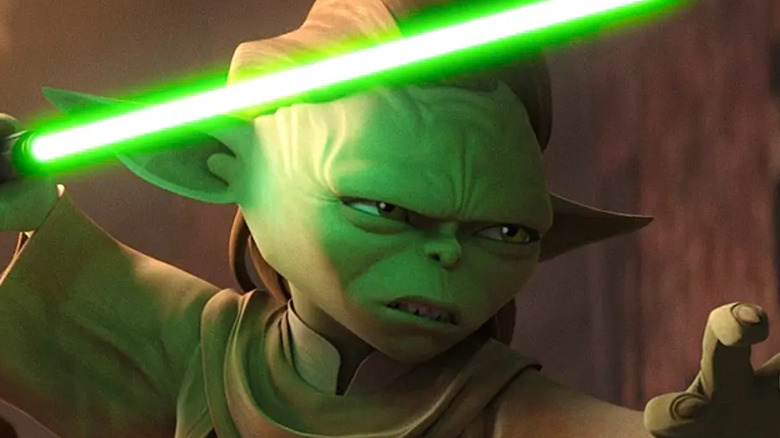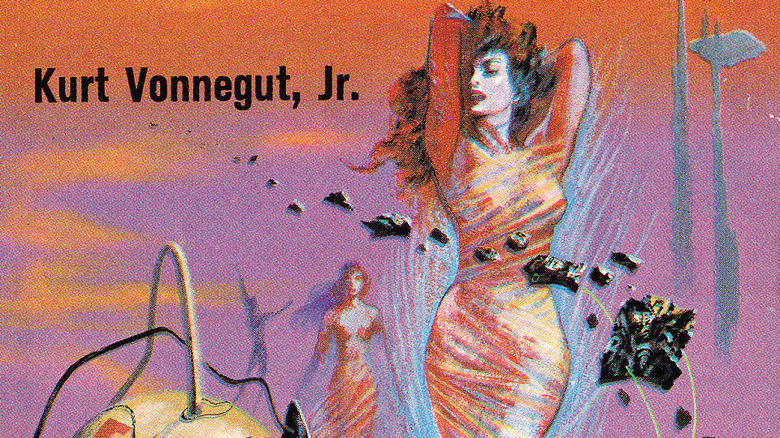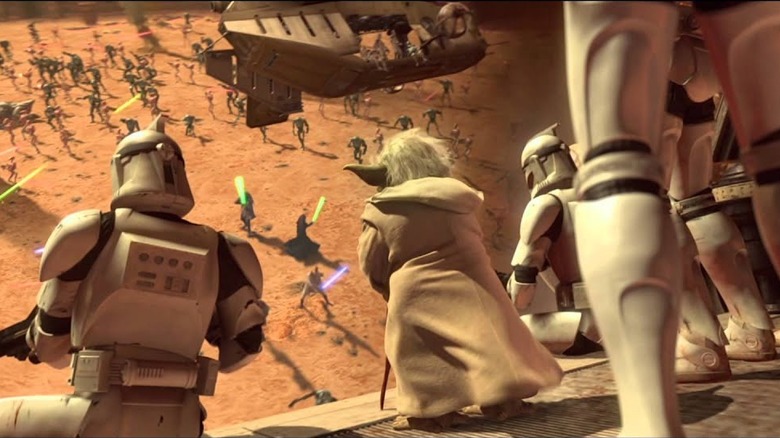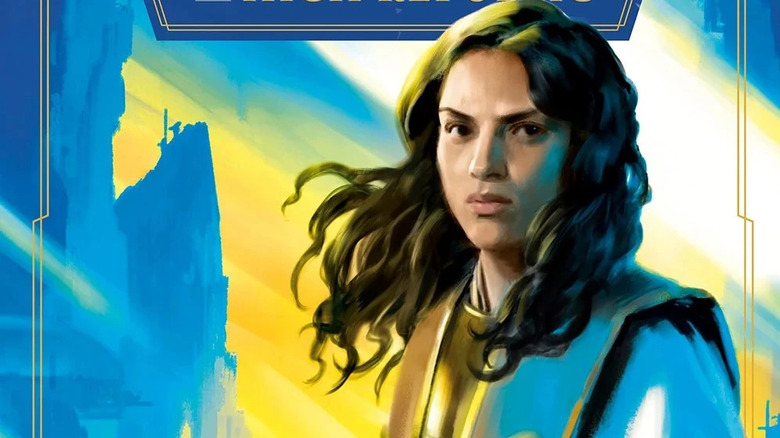Star Wars: The High Republic - Cataclysm Tears The Setting Apart And Moves It Forward
There will be spoilers for "Star Wars: The High Republic: Cataclysm" by Lydia Kang.
"Star Wars: Cataclysm" is the latest installment of the second wave of the "High Republic," and the flagship title to advance the story into its next step. Phase two of "The High Republic" is set 150 years before the events of the first phase and sets the technology and events of the galaxy back to a more primitive level. Communications are difficult, and the ever-expanding galaxy is harder and harder to govern for the Republic. In the first part of phase two, we were introduced to the twin planets of Eiram and E'ronoh, which were locked in a long, protracted war. The Republic and the Jedi wanted to unite these two and cease the hostilities. They came to a tentative agreement and vowed to sign a peace treaty together on Jedha. Unfortunately, the signing of that treaty was interrupted by the Path of the Open Hand — a shadowy organization that has a personal vendetta against the Jedi — and a battle broke out, with each side declaring treachery from the other.
That's the stage upon which "Cataclysm" is built. As everyone looking into the greater conflict looks deeper, all roads lead to the planet Dalna. A number of Jedi in different situations, each chasing different problems and leads, all end up on Dalna seeking answers. Unfortunately, the Mother is ready for them and has a trap set, including the use of her secret Leveler, a beast that consumes Force-sensitive individuals, turning them to ash.
The Jedi are able to unite all the relevant parties by the end of the Battle of Dalna and turn the tide of the fight, but by then it's too late. Many Jedi have paid the ultimate price and have transformed into the Force, and the Mother has escaped and her grand designs are still every bit a mystery.
The book follows many characters we've read about before, either in print or audio. Axel Greylark and Gella Nattai from Zoraida Cordova's "High Republic: Convergence" are two of the most prominent characters. It's Greylark who appears on the cover with one of Jedi Nattai's lightsabers. Creighton Sun and Aida Forte appeared prominently in George Mann's "The Battle of Jedha" and play important roles here as well. As for the Mother and the Path of the Open Hand, her story has been winding through the shadows across every story of the second phase of the High Republic.
This book brings all the current threads together and serves as a launchpad for the next step of the second phase of "The High Republic."
Yaddle's involvement
One of the central characters in this book is none other than Yaddle. Yaddle first made a brief appearance on the Jedi Council in "The Phantom Menace" and never really appeared on screen again until last year's "Tales of the Jedi" series, where we saw what her tragic fate was between "The Phantom Menace" and the onset of the Clone Wars.
This book is set hundreds of years before those events, though, and we see more depth added to her character. We also see how she differentiates herself from Master Yoda (who also plays a pivotal part in this novel.)
Yaddle seems to be, above all, a nurturing teacher. Over the course of this book, she's accompanied by a Jedi Youngling — too young to be a padawan — because they are extraordinarily gifted in the Force and need to have a more challenging curriculum. To that end, Yaddle is tasked with taking this young charge around the galaxy, despite how much trouble she can get into. There's a moment between the two that echoes Qui-Gon Jinn and Anakin Skywalker in "The Phantom Menace." Qui-Gon tells Anakin to stay safe, hiding in the cockpit of an N1 Starfighter, but Anakin ends up in the thick of the battle, risking his life. Yaddle tells the youngling to hide in a root cellar at one point and is dismayed to find that she's dragged the youngling into a warzone. Cippa, the young Arkanian girl, just wants to help the Jedi and fight in the battle.
It feels like it's the year of Yaddle, and the character is finally getting the treatment she deserves ... aside from the on-screen depiction of her brutal death.
The Sirens of Titan
One of the central ideas of this novel that really grabbed me was the idea that common enemies unite people who would ordinarily be on opposite sides. As the conflict between Eiram and E'ronoh intensifies after the Battle of Jedha, it seemed as though nothing short of a miracle would bring them together.
As evidence of the meddling between their planets on the part of the Path of the Open Hand becomes more apparent and undeniable, these two planets, at war for ages, are able to put aside their differences and go on the offense with a united front. It reminded me very much of one of the central themes in Kurt Vonnegut's book "The Sirens of Titan." In that book, a wealthy aristocrat named Winston Niles Rumfoord was caught in something called a chronosynclastic infundibulum and was able to use his wealth and time traveling and phasing abilities to engage the Earth in a war based on Mars. His thinking was that the only way to get the people of Earth united was to have them all under attack by the same external threat — in this case the Martians. This idea was something Alan Moore used again for Adrian Veidt's plan in the original "Watchmen" graphic novel.
It's a common theme and great to see Lydia Kang use it to such sharp effect in the trappings of the "Star Wars" universe.
Details to watch out for
Aside from that moment echoed in "The Phantom Menace" above, there were other great touchstones from the "Star Wars" movies. At the climax of this book, the forces of Eiram and E'ronoh arrive with Master Yoda leading them. With the Jedi on the planet of Dalna, soaking in mud (in a very "climax of 'Seven Samurai'" sort of way) and weary from such a prolonged battle they couldn't hope to win without reinforcements, Yoda arrives at exactly the right moment narratively as he does in "Attack of the Clones." For what it's worth, both moments, in the original "Star Wars" film and in "Cataclysm" also feel thematically linked to the moment in "The Two Towers" when Gandalf arrives with the Rohirrim.
This book also raises the specter of being able to commune with dead Jedi, as Qui-Gon does with Yoda hundreds of years later in "The Phantom Menace," but quickly dismisses it. At this point in time, it's nothing more than rumor or hearsay that anything like that could be possible. But there is a character later in the book who thinks she feels someone in the Force beyond their death. It's an interesting exploration of this idea that's been a question in the canon for so long.
The battle at the climax of this book becomes known as "The Night of Sorrows" which feels like an echo of the "Night of a Thousand Tears" we've been hearing about so much of in "The Mandalorian." Itself is a play on things like "The Night of Long Knives" and other similarly named tragedies in history.
It was nice to see Canto Bight get a nod, too, even if at this point in the timeline, it's a playground for the fabulously spoiled and wealthy. It was a place where the privileged Axel Greylark spent time.
Cataclysm
This was another solid entry in the "High Republic" canon. It definitely raised questions for me about where we're heading and how we're getting there, but also about the nature of the Mother—the leader of the Path of the Open Hand. One of the chief questions raised by this book (and all of the books in the second phase of the initiative before this) is who is she. Why is she doing what she's doing? Why does she hate the Jedi so much?
It makes me wonder if we might have a more sinister answer in store, because it seems as though she's a proto-Palpatine. Could she be a secret Sith trying to bring about the destruction of the Jedi? It makes me wonder if they'd actually go that far, to delve into the Sith so close to the midpoint of their disappearance—at least according to Master Ki-Adi-Mundi in "The Phantom Menace."
Seeing the story move forward is exciting, and it feels like we've been given an ending here that hearkens back to "Attack of the Clones." Sure, Axel Greylark and his mother have reconciled and the Eiram and E'ronoh have set aside their differences, but it feels like a massive war has just started and the chief instigators of that war are still out there and no one has any real idea about their true intentions.
I can't wait to see what happens next in this era of storytelling and it drives us ever closer to what will cap off the era in the eventual Disney+ show "The Acolyte."
"Star Wars: The High Republic: Cataclysm" is available now wherever you buy books.
